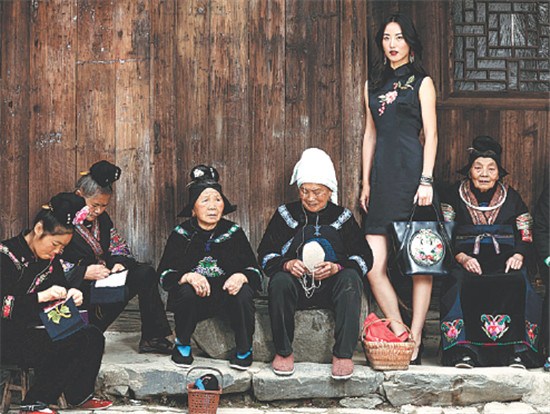
Models for Eve show off the brand's new collections with embroidery patterns inspired from ethnic Miao works in Jidao village, Guizhou province. (Photo provided to China Daily)
Chinese fashion brand Eve takes inspiration from the Miao group to add a rare touch to its products. This, in turn, is helping an old tradition survive. Sun Yuanqing reports.
Tucked away in the mountains, Jidao village is a three-hour drive from Guiyang, the provincial capital of Guizhou province. Here, the ethnic Miao people maintain their traditional lifestyle. They live in wooden houses, preserve meat in early winter and hold gatherings at the riverside to remember their ancestors every year.
On the face of it, all this might seem to have no connection with high fashion, but the community has been a source of inspiration for many designers and fashion houses, including fashion brand Eve.
The Chinese brand recently made a trip to the village to make an advertising campaign for its 2017 spring/summer collection, which features Miao embroidery.
Inspired by the sea, the collection features shades of blue on its suits, sweaters and coats. A smattering of embroidery adorns the classic suit silhouette.
The women's collection includes sleek qipao (traditional Chinese women's dress) and dresses that highlight nature-inspired embroidery.
While traditional Miao embroidery is intricate, Wu Chaohui, creative director of Eve's menswear line, says the brand has simplified it to cater to customers' modern-day needs.
"Traditional Miao embroidery is usually very rich and exaggerated, while modern menswear is understated. So we try to use it (the embroidery) in a selective, moderated way," he says.
"We want to revive this heritage by offering it to an urban clientele, and we hope this tradition will live on."
Eve has been working on a project to preserve Miao embroidery over the past 15 years with a dedicated team that documents the traditional craftsmanship.
It has established a network of craftspeople and their work, and this has been used extensively in their collections and shown at exhibitions and runway shows in Milan, London and Paris in recent years.
Separately, Eve has also formed an alliance with local brands, so that all its members can make use of the database.
In a related development, it has also helped build a museum in Guizhou to exhibit the works of the embroiderers.
Xia Hua, founder and chairwoman of the Eve Group, says: "These people are preserving their heritage with their hands. I want to share their craftsmanship with the world, and to let it see the beauty of our country."
Xia was a teacher at the China University of Political Science and Law before founding the Eve Group in 1994.
Eve is best known for making men's suits, and it has dressed Chinese magnates Jack Ma and Liu Chuanzhi. The company now has five brands-Eve de Uomo, Notting Hill, Kevin Kelly, Jaques Pritt and Eve Cina.
The prices of its outfits range from a few hundred to more than 10,000 yuan ($1400).
The group currently has more than 500 stores in China, including a designer space in Beijing's Parkview Green mall that showcases its collaborations with international and local designers.
The growing interest in Miao ethnic culture is also changing the lives of villagers.
In Jidao village, embroiderers now hold workshops to teach children the craft.
There are about 50 embroiderers in the village, with the oldest being more than 80 years old.
With regard to overseas exposure, the embroiderers were taken by Chinese designer Xie Feng to Paris Fashion Week in 2012 to exhibit their skills.
As their craftsmanship has gained more exposure over the years, orders have flooded in.
Now, looking to secure their future, the embroiderers have formed a foundation, and they contribute 3 percent of their revenues to it.
The foundation now has a fund of around 6,000 yuan, which they intend to use to promote their art, says Chen Qin, an embroiderer and one of those behind the foundation.
"It (the foundation) is like a seed. We will use it to spread our heritage," she says.


















































